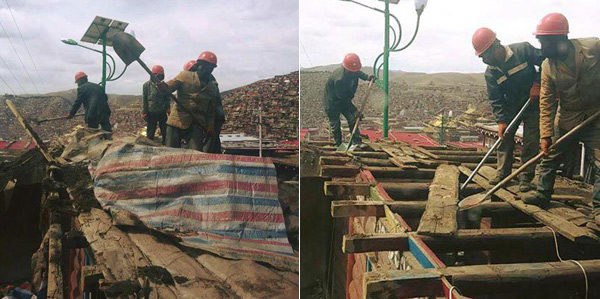- Security has been intensified in Kardze (Chinese: Ganzi) where a 24-year old Tibetan farmer, Pema Gyaltsen, set fire to himself on March 18.
- A video has emerged from another area in Kardze, Serthar (Chinese: Seda), which appears to show Tibetan pedestrians in traditional clothes being attacked and brutally beaten by police. A voice over removed from the video footage, circulated by Voice of America, reflects shock and sadness among onlookers, with one voice saying over and over again, “They are doing this for no reason at all.”.
- Tensions are high in the Serthar area, which is close to the religious institute of Larung Gar, also in Kardze Tibetan Autonomous Prefecture in Sichuan, the Tibetan area of Kham. Images and video of more demolitions at the religious institute over the last few days are circulating on social media.

Pema Gyaltsen
After the self-immolation, Tibetan onlookers who are believed to have shouted out in solidarity or simply witnessed the burning, were detained and around ten members of his family were brutally beaten and held overnight, according to Tibetan sources. A video circulating on social media depicts armed police in the streets after the incident, with the sound of someone sobbing apparently in shock.
Pema Gyaltsen, an unmarried farmer, was heard to call for the return of the Dalai Lama to Tibet and for freedom in Tibet, according to exile Tibetan sources. He was the eldest of five children and the main provider for his family. He had not attended school and had been a monk for a short time as a child. His self-immolation was the first in Tibet this year.[1]
Relatives of Pema Gyaltsen went to the Kardze county town Public Security Bureau office immediately after the self-immolation to find out where he was and whether he was still alive. Instead of receiving a response they were detained and held overnight, where they were brutally beaten to the extent that some had to be hospitalized later, according to Tibetan sources. A Tibetan source told Radio Free Asia that the next day: “Some of them could barely walk from the beating, but they were released under the guarantee of a Nyagrong official.”
Links to the area via internet and mobile phones were cut following the self-immolation.
Demolitions begin again at Larung Gar

Images and footage of demolitions in the last few days at Larung Gar religious institute in Serthar, the Tibetan area of Kham.
Demolitions and expulsions have begun again at the world-renowned Buddhist institute of Larung Gar in Kardze, Sichuan, with the destruction of homes now due to be completed by the end of April. Videos circulating on social media depict monks looking on silently as homes are torn apart by work teams in hard hats.
According to an abbot at the religious institute, a total of 4,828 monks and nuns have left Larung Gar, and around 250 nuns from Qinghai are left to leave, according to a message on March 23 to religious practitioners obtained by Radio Free Asia. The abbot said: “Those who have left had never wanted to leave. All left against their own wish. And whether or not they had some place to go, they still had to leave.”
Tibetan religious teachers at the monastic encampment have consistently urged monks and nuns at the institute not to protect the demolition and evictions but to remain calm and concentrate on the religious practice and long-term survival of the institute.
According to one of the religious teachers, the Chinese authorities reduced the number of monastic dwellings at Sichuan’s Larung Gar Buddhist Academy targeted for destruction to 3,225, in response to appeals by the management committee of the complex, according to a respected teacher at the institute.
The decision, announced on March 12, followed the announcement of a projected total of 4,320 demolitions announced earlier on January 13, according to information published by Radio Free Asia.
The demolitions and expulsions at Larung Gar and Yachen Gar witnessed since July 2016 are part of an unfolding political strategy involving more aggressive measures in order to curb and manage the growing influence and number of monks and nuns at these important monastic centers of study and Buddhist ethics in eastern Tibet, the largest such institutes in the world. An ICT report documents how at the same time as undermining religious practice and teaching and stepping up intrusive security measures, the Chinese authorities are using this very interest in Tibetan Buddhism to attract domestic tourists, leading to fears of further diminishment of these monastic communities, popularly known as ‘encampments’ or ‘chogars’ in Tibetan. (ICT report, ‘Shadow of Dust across the Sun’).
The atmosphere in the nearest town of Serthar has been tense since the demolitions began. Local people who wished to protest the destruction were requested not to do so by religious teachers at the institute, fearing it would make matters worse. The context of a video circulating on social media and depicting brutal beating of Tibetans in Serthar town is not known but it underlines the tensions and violent responses of security forces in the area. The video can be viewed at: http://www.voatibetanenglish.com/a/3779999.html
March, the anniversary of the 1959 uprising and the protests that swept across the plateau in 2008, is a politically charged month in Tibet. It is closed to foreigners during this period and intimidating military drills and exercises have been witnessed in various areas of the plateau.[2]
CORRECTION. ICT initially reported that Pema Gyaltsen set himself on fire near a monastery in Nyagrong in Kardze Tibetan Autonomous Prefecture. It has since emerged that while he is from Nyagrong, he set himself on fire in Kardze county town. We have corrected this error in this report.
Footnotes:
[1] https://savetibet.org/resources/fact-sheets/self-immolations-by-tibetans/
[2] Also see ICT report, March 3, 2017, https://savetibet.org/ict-inside-tibet-tibetan-new-year-marked-by-security-agenda-mass-deployment-of-troops-for-prayer-festival/

